Those of us who’ve been fly fishing for a while have a tendency to drift gently toward nostalgia. If we go back far enough, our memories reveal uncrowded rivers and eager trout, while our sport, which now sprawls across an entire “fly fishing industry,” seems less an industry and more a collection of memorable characters. At the same time, the writing, or at least the best of the writing, displays a patina of intimacy and respect you’d be hard pressed to find today.
With that in mind, it’s not much of a leap to use angling as a metaphor and to wax poetic about the good old days. Lest we’ve forgotten, there was a time when quality was more important than marketing hype, and when we called ourselves citizens rather than consumers.
As much as we like to pay homage to the past, though - and I’ll admit that I’m as guilty as anyone else - we do ourselves a disservice if we pray too much at the alter of Roderick Haig-Brown & John Voelker. We’re alive now, in this moment, and we can’t roll back the clock. So here, for your consideration, is a story that stretches back not centuries, not decades, but only a few short years.
It was the beginning of July when Troy Jones and Gary White jumped on an airplane in Hartford, Connecticut and flew west for a little early-summer trout fishing. I met them at Glacier International Airport in Kalispell, Montana and after shaking hands and grabbing luggage, had to apologize for my truck’s broken air conditioner. It was hot to the point of absurdity and my pickup, which had been sitting in the parking lot for the better part of an hour, felt like the inside of a sweat lodge.
I wish I could tell you otherwise, but it turned out that British Columbia, our eventual destination, was just as unbearable. You’d think that all those snowcapped Canadian mountains would cool things off, but it was scorching; almost a hundred in the shade. We caught a bunch of west slope cutts over the next few days, and even a few nice ones, but it was so hot for so long that when Troy and Gary finally flew home, they looked like a couple of sunburned asses from Maclean’s infamous sandbar.
And that’s how it went that July. Bluebird skies, a whole string of record high temperatures, and angling as sordid and ugly as you’ve ever seen. The Missoulian reported fish kills on the Big Hole, the Smith, the Yellowstone and the Firehole. I spent a sweaty evening wading the Flathead and never even saw a trout rise. Then August rolled in with wildfires to our north, south, east and west and proceeded to smoke us out.
I’ve lived in Montana since Bush the Elder was President, but I’ve never seen anything like that summer (well, at least not until 2015). It was surreal, especially when the editor of the local Kalispell newspaper ignored the fires and evacuations, not to mention the recent IPCC (Intergovernmental Panel on Climate Change) reports, and wrote, “Even if it is conclusively proved that there has been a temperature increase during the last two centuries, there is no way to conclusively prove that the change was caused by humans. It could just be coincidence.”
A man of science he’s not.
When September finally nudged a soot-filled August aside, I left the hot weather behind and flew north to Alaska. Alaska Sportsman’s Lodge, to be precise; on the Kvichak River a few miles downstream from the cold, clear waters of Lake Iliamna. If you’ve never visited the Kvichak, you should. It’s an amazing place, with trout, salmon, bears and wolves, all of whom occupy their respective places on a food chain that stretches back millennia.
The fishing was wonderful, too, with rainbows you could only dream about in the Lower 48. I spent my days with some truly stellar anglers, hooked and landed trout of ten pounds or better, and generally lived like a king. The one thing that put a damper on the week - and by damper, I mean the kind of Grendel-driven miasma you'll remember from the epic poem Beowulf - was contained, if only for the moment, in three ominous words. The Pebble Mine.
You’ve probably heard about Pebble. I went to Alaska to write about it; to walk around the earthquake-prone ground where people from Planet Greed want to build a monstrous gold and copper mine. That’s right. Imagine, if you will, an earthen dam better than four miles long and 700 feet tall, holding back a few billion tons of toxic mine tailings atop the most biologically productive trout and salmon fishery on the continent.
There’s not really much you can say about that, with the possible exception that any man intemperate enough to file the paperwork for Pebble should be hung by his testicles from a dead Alaska spruce and left for the eagles and the ravens. Assuming - and there’s a big “if” involved here - that the eagles and ravens would even touch him.

Forgive me for being blunt, but it’s not a good thing when we decide to poison one of the most pristine, productive ecosystems on the planet. It’s not good from a moral perspective, or from an environmental perspective, or a social, or economic, or spiritual perspective. In fact, it’s insanity; insanity bereft of the finer aspects of human nature and completely beholden to money-grubbing avarice.
To quote from Shakespeare’s King Lear, “O, that way madness lies; let me shun that; no more of that.”
Anyway, enough about the Pebble Mine. It’s too damn depressing, and there’s no point sending my blood pressure through the roof all over again.
A couple of weeks after I flew home from Bristol Bay, I headed down to the Missouri River near Wolf Creek and Craig. I’ve fished that particular stretch of water since 1990 and there’s something about those long, slow glides and dry fly-sipping trout that seems ... well, the two words I’d like to use are “just right.” The Missouri might not be an intimate waterway, at least not in the traditional sense, but it offers the kind of routine generosity our kids expect from Santa Claus and the Easter Bunny.
I was with two of my wife’s brothers, Pete and Pat, and it was Pete’s first time on the river. We drove over from the Flathead through a kaleidoscope of mountains and sunshine and fall colors, paralleling first the Swan and then the Blackfoot along the way. Unfortunately, when we finally crested the continental divide and dropped down to the Missouri, our blue skies had vanished and we were left with dark gray storm clouds, a biting wind, and a total absence of rising trout.
“Bummer” was the operative word.
The three of us stopped and checked out the river at the Wolf Creek bridge, then drove downstream to an empty pull-off below the little town of Craig. After a short powwow, we strung our rods and hiked in a mile or so to a distant flat.
And there we were; no bugs, no fish and a strong breeze in our faces. It was shaping up as the proverbial wasted day. Then a strange thing happened. The wind dropped.
Not only did the wind drop, but Blue Winged Olives started popping and oversized trout began rising pretty much everywhere. It was sublime, in the sense that, yes, the fish were picky and the bugs were small, but if you did everything just right - the right fly, the right leader, the right presentation, the right drift, the right entreaty to your distant ancestors - you had a better than even chance of hooking up; if not on this cast, then on the next; if not on the next cast, then on the one after.
I’ve fished an awful lot of rivers, but I’ve never found one more consistently generous than the Missouri. It truly is a special place.
As good as it was, though - and it was very good, to the point where Pete decided he’d fallen in love - there was a problem impacting the watershed; one that made our overall experience considerably less enjoyable.
Call it “weeds,” or call it “salad,” or call it whatever you prefer, but there’s a lot more floating vegetation in the Missouri than there used to be. Huge mats of debris drift downstream on the river’s surface, while the entire water column is so full of aquatic crap that you can’t throw a nymph or a streamer without fouling the hook on a regular basis. It’s a royal pain in the ass.
So what’s going on? Opinions vary, but the most persuasive theory I’ve run across was offered up by a local outfitter who used to work as a Montana Fish, Wildlife & Parks biologist. He blames the treated sewage from Bozeman, Three Forks, Big Sky and Belgrade for the Missouri’s ever-more-irritating vegetable stew. He’s confident that effluent from the upstream sewage treatment plants is acting like fertilizer for the river’s algae and aquatic vegetation. If he’s right - and the facts seem to support his hypothesis - then those nutrients have turned an already fertile ecosystem into a fishery on steroids, or, if you prefer, a river smoking Miracle Grow.

Fatal? Probably not; at least not any time soon. But it’s still a perfect example of what happens when a society predicated on endless growth and limitless expansion bumps up hard against the natural world. “Progress” rolls on, while nature gets knocked off kilter.
Anyhow - or as the comedian Jon Stewart says, “anywhooo ....” - we caught our fair share of trout in spite of all the floating vegetation and I finished off the trip with a nice rainbow I hooked while sitting cross-legged in the middle of a willow-laced mud flat.
Don’t laugh. No, I didn’t get any points for style, or for that matter, for cleanliness, but there’s something wonderful about a trout that requires a twenty yard slither through pungent ooze and then a wrong-shoulder, into-the-wind cast with a willow thicket at your back. If you’re lucky enough to stick that fish - and yes, luck plays a major part in the final outcome - you’re entitled to wear the mud on your backside with a little bit of pride.
By the way, I rinsed off my waders before I drove home. No point in helping the latest invasive mud snail (or zebra mussel, or Didymosphenia slime, or exotic aquatic disease) spread all over Montana.
Now it’s time for a bit of uncomfortable honesty. If I had my druthers, I’d wrap things up at this point and skip the next section altogether. But since I can’t do that, at least not and save my soul, it’s time to move on to West Virginia.
West Virginia, and a beautiful little brook trout stream covered in garbage.
Okay, let me explain. The garbage, which consisted of tin cans, mattresses, old tires, rusted metal implements of indeterminate use and vintage, and the occasional plastic soda bottle, was scattered all over the place. Yet if you didn’t look too hard, if you sort of squinted and turned your head at the appropriate times (which is a process those of us who’ve scaled the mountain of middle age use when we look in the mirror), it wasn’t quite so bad. You could almost put the trash out of your mind and focus on the brilliant October foliage. Almost.
But the garbage wasn’t the worst of it. As a couple of local Trout Unlimited members pointed out to me, a more enlightened landowner might eventually clean things up and leave a landscape worthy of the stream’s native brookies. Some problems, though, are so pervasive and so cataclysmic that they simply can’t be overcome.
Indulge me for a moment. Imagine that six months have passed in the blink of an eye and you’ve just found yourself standing next to a handsome West Virginia brook trout stream. You’re looking at the creek as the sun shines down on your back and a little upstream waterfall makes glorious, if subtle, music. Then, out of nowhere, you hear an explosion; an explosion so strong that it literally shakes the ground under your feet. A few moments later you see a cloud of dust, thick and acrid, descending around you and filling the forest. And the realization strikes home that someone is tearing down the mountain to your east, and that they’re going to dump all the leftover rubble on top of your stream.
Makes you feel all warm and fuzzy, doesn’t it?
That’s the truth of it, back in West Virginia. Hundreds of miles of streams have been buried under debris. I can’t put it any clearer than that. The tiny brook trout creek I fished may well disappear over the next couple years. Others, too. Not to mention the toll that Mountain Top Removal mining takes on the rest of the landscape, and on the people who live nearby.
Let’s be clear about this. We’re allowing corporations to tear down our mountains and dump the leftover detritus in the nearby hollows and creek bottoms so that we can burn coal in our power plants and create “cheap” electricity. Cheap as long as we don’t look at external costs like the mercury contamination of our waterways, or the global warming that’s melting glaciers in Montana and super-charging droughts around the globe, or the acidification of not only our high mountain lakes but also, unbelievably, of our oceans, to the point where many of our steelhead and salmon runs may eventually disappear forever.
It’s a vicious cycle, and as hard as it is to accept, it’s possible to trace the impacts of global warming and ocean acidification to the kind of coal mining I saw in West Virginia. I was on a conference call with three Nobel Prize-winning IPCC scientists a while back and they described the long term prospects for our Pacific salmon, and by extrapolation, for our steelhead, as “very dim.”
Think about that for a second. Our top scientific experts are not only warning us about changes in PH and rising ocean temperatures, but they’re actually telling us that our salmon and steelhead are in serious trouble. As we used to say back in the 70s, “Put that in your pipe and smoke it.”
So there, in chronological order, are my admittedly subjective impressions of a four month stretch from July to October. I started out with record high temperatures in the Canadian Rockies, ran into unbelievable wildfires in Montana, and then experienced a ticking time bomb in Alaska, an effluent explosion on the Missouri, and mass destruction in West Virginia. In just four months. It’s enough to boggle the mind.
At the same time, I suspect that some of you will want to know what all this has to do with fly fishing. After all, it’s obvious that I missed my opportunity to write about the delicate nature of a mayfly’s wings, or the joyful experience of casting a size 20 rusty spinner to a spring creek rainbow. Hell, I didn’t even mention my beautiful 7’ 9”, 5- weight split-cane fly rod; courtesy of master rodmaker Rick Cunningham. So how does this overwhelming negativity relate to our angling? Is it even worth bringing up when we could be talking about our favorite tarpon lodges or discussing Marinaro’s classic In The Ring Of The Rise?
Well, here’s the thing. We live in the real world; the physical world. We’re part of nature. Our existence depends on fresh air and clean water, and we need a planet where the ecosystems are fully functional. Not just for our survival, although that’s obviously paramount. But so that we can wade into a trout stream, or a steelhead river, or onto a bonefish flat, and touch nature in the raw with enough passion and respect that those qualities come back to us amplified a hundred fold.
The essential human experience requires a deep connection to our lands and waters. Anything less and we risk the sort of social psychosis characterized by video game addiction and the destruction of our planetary life support systems. In other words, if we lose our link to nature, we risk losing everything else.
“Whatever befalls the Earth befalls the sons of the Earth. Man did not weave the web of life; he is merely a strand in it. Whatever he does to the web, he does to himself.”
Those are the words of Chief Seattle of the Suquamish People, but the same warning echoes down from giants like Henry David Thoreau, Albert Einstein and Aldo Leopold. Unfortunately, we’re tasked to live in an age where the risks have never been greater, or our relationship with nature more tenuous. Which is why fly fishing, whether with traditional bamboo or high-tech graphite, is so vital. It tethers us to reality and gives us a perspective we’d be hard pressed to find anywhere else.
In retrospect, I suppose I could have focused on a more uplifting narrative. I probably could have told you about the five years I spent guiding on the Henry’s Fork, or about my admiration for great anglers like Craig Mathews and Rene` Harrop, or even about my adventures with my son Kian. Any of those topics would have been worth a few hours of my time, and perhaps of yours.
Yet at the end of the day, we have to be honest with ourselves. Our modern culture seems so intent on creating a paean to greed and shortsightedness that the future is literally slipping through our fingers. If we don’t take our responsibilities to our children and to the planet seriously, if we don’t emphasize stewardship and sustainability while we still have the chance, then fly fishing, with its enchanting rhythms and unadulterated connection to nature, will likely follow the dinosaurs and the dodos down the moldy path of extinction.
I don’t know if I can live with that.






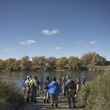


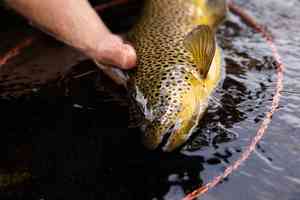



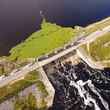

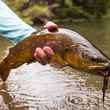




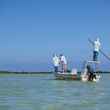




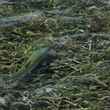
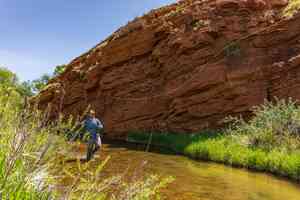


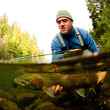
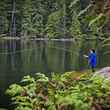
Comments
Chris replied on Permalink
Climate change is real. The effects will be felt with increasing adversity until our 'free' energy has all been spent and centuries have passed. All we can do as a species is 'slow the burn' of these carbon stores. Every time we turn on a light, drive to work or take a flight to some slowly spoiling trout mecca, demand for the fuel that drives nature's demise grows, or at the least, remains at a destructive equilibrium. The examples you presented are the more visible, catastrophic impacts, but they are driven by our insatiable need to feed our creature comfort habits.
Stirling Tyler replied on Permalink
The editor of The Daily Interlake (Kalispell's local newspaper) is one of the biggest panderers to the far right that you'll ever come across. Just a complete tool!
Pages